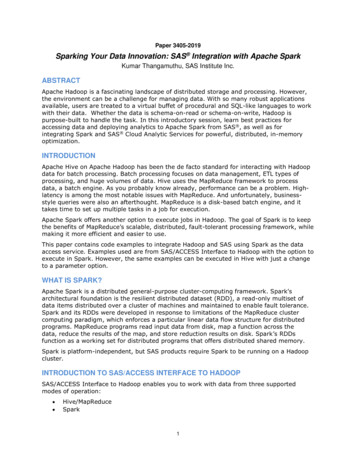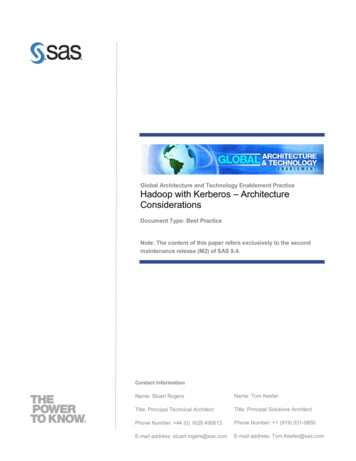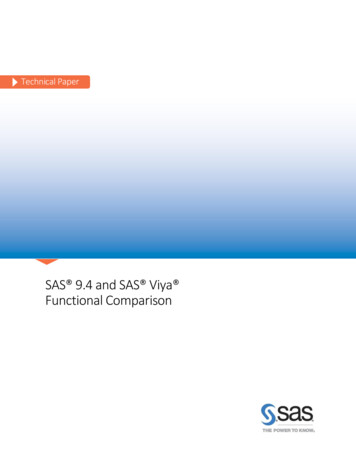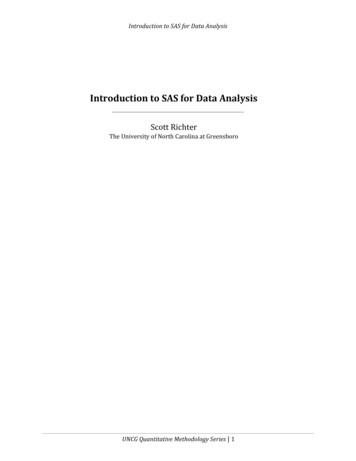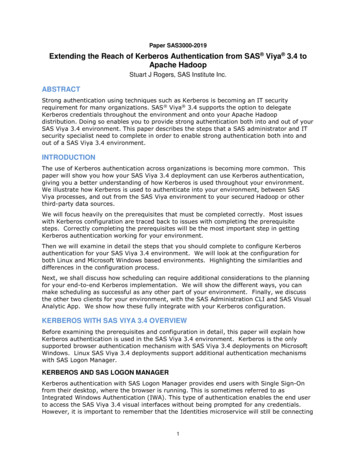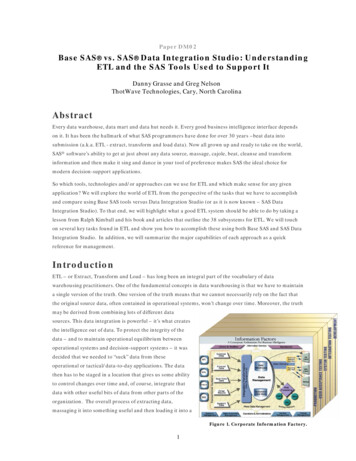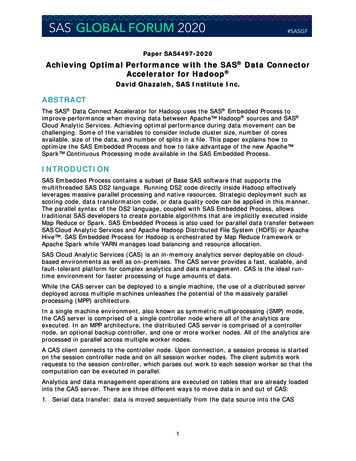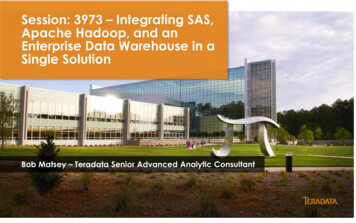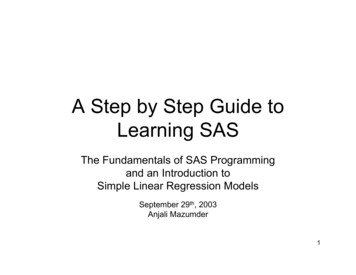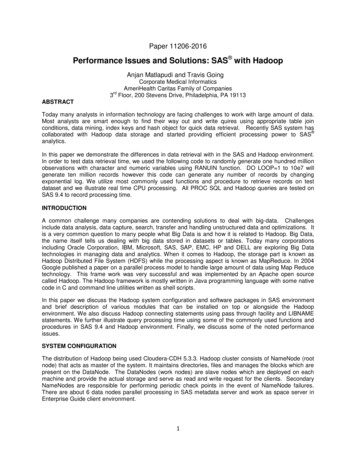
Transcription
Paper 11206-2016Performance Issues and Solutions: SAS with HadoopAnjan Matlapudi and Travis GoingCorporate Medical InformaticsAmeriHealth Caritas Family of Companiesrd3 Floor, 200 Stevens Drive, Philadelphia, PA 19113ABSTRACTToday many analysts in information technology are facing challenges to work with large amount of data.Most analysts are smart enough to find their way out and write quires using appropriate table joinconditions, data mining, index keys and hash object for quick data retrieval. Recently SAS system has collaborated with Hadoop data storage and started providing efficient processing power to SASanalytics.In this paper we demonstrate the differences in data retrieval with in the SAS and Hadoop environment.In order to test data retrieval time, we used the following code to randomly generate one hundred millionobservations with character and numeric variables using RANUIN function. DO LOOP 1 to 10e7 willgenerate ten million records however this code can generate any number of records by changingexponential log. We utilize most commonly used functions and procedure to retrieve records on testdataset and we illustrate real time CPU processing. All PROC SQL and Hadoop queries are tested onSAS 9.4 to record processing time.INTRODUCTIONA common challenge many companies are contending solutions to deal with big-data. Challengesinclude data analysis, data capture, search, transfer and handling unstructured data and optimizations. Itis a very common question to many people what Big Data is and how it is related to Hadoop. Big Data,the name itself tells us dealing with big data stored in datasets or tables. Today many corporationsincluding Oracle Corporation, IBM, Microsoft, SAS, SAP, EMC, HP and DELL are exploring Big Datatechnologies in managing data and analytics. When it comes to Hadoop, the storage part is known asHadoop Distributed File System (HDFS) while the processing aspect is known as MapReduce. In 2004Google published a paper on a parallel process model to handle large amount of data using Map Reducetechnology. This frame work was very successful and was implemented by an Apache open sourcecalled Hadoop. The Hadoop framework is mostly written in Java programming language with some nativecode in C and command line utilities written as shell scripts.In this paper we discuss the Hadoop system configuration and software packages in SAS environmentand brief description of various modules that can be installed on top or alongside the Hadoopenvironment. We also discuss Hadoop connecting statements using pass through facility and LIBNAMEstatements. We further illustrate query processing time using some of the commonly used functions andprocedures in SAS 9.4 and Hadoop environment. Finally, we discuss some of the noted performanceissues.SYSTEM CONFIGURATIONThe distribution of Hadoop being used Cloudera-CDH 5.3.3. Hadoop cluster consists of NameNode (rootnode) that acts as master of the system. It maintains directories, files and manages the blocks which arepresent on the DataNode. The DataNodes (work nodes) are slave nodes which are deployed on eachmachine and provide the actual storage and serve as read and write request for the clients. SecondaryNameNodes are responsible for performing periodic check points in the event of NameNode failures.There are about 6 data nodes parallel processing in SAS metadata server and work as space server inEnterprise Guide client environment.1
Below figure showing SAS/ACCESS connects to Hadoop NameNode to send data to be distributed withinHadoop or retrieve data from Hadoop system.The Hardware configuration includes HP DL380 G9, 2 X 8 Cores CPU (Intel) Xeon E5-2650, 8 X 2TB 6GSAS 7.2K HDD, 2 X 10GigE Intel NICs using 256 GB Ram hard disk space .HADOOP ECOSYSTEMHadoop managed by Apache Foundation is a powerful open-source platform written in java that iscapable of processing large number of datasets in a distributed fashion on a cluster of computes usingsimple programming models. It is designed to scale up from single server to thousands of machines, eachoffering local computation and storage.Hadoop Distributed File System (HDFS) designed to store very big datasets by distributing storage andcomputing across many servers and to stream the data from big datasets at high bandwidth to userapplications.Hadoop YARN is a resource management framework responsible for job scheduling and cluster resourcemanagement.Hadoop MapReduce is a YARN based programming model for parallel processing of large datasets.Sqoop name comes as the combination of first two letters from Sq(l) and last three letters of (Hd)oopwhich serves the most important function to import data from relational database into Hadoop usingJDBC.2
Beyond HDFS, YARN and Map Reduce, the entire Apache Hadoop platform consists of number of otherrelated projects as well as below mentioned framework.Hive is data warehousing framework to query and manage large datasets stored in Hadoop. It is data warehouse system that facilitates easydata summarization, ad-hoc quires and analysis of large datasetsstored in Hadoop compatible file system It provides a mechanism tostructure the data and query the data using an SQL-like languagecalled HaviQL quires are compiled into MapReduce programs.Pig platform for data analysis that includes stepwise proceduralprogramming that converts to MapReduce. Hive and Pig provides lesscomplex higher-level programming methods for parallel processing ofHadoop data files.Apache ImpalaApache Impala is an open source, native analytic database forApache Hadoop. Impala is shipped by Cloudera, MapReduce, Oracleand Amazon.Mahout is a data mining library for Hadoop particularly used forrecommended engines. Just like mahout drive the real elephantHadoop Mahout drives and provide scalable MapReduce algorithms.HBase is a column-oriented database management system. HBase isnot operational without Zookeeper.SqoopSqoop is used to import data from relational database into Hadoopusing JDBC.Oozie is a workflow coordination system to manage Hadoop jobs.SAS/ACCESS INTERFACE TO HADOOPSAS/ACCESS to Hadoop provides efficient way to access data stored in Hadoop via HiveQL. In order toconnect to Hadoop you can use either LIBNAME or pass-through statement. The below LIBNAMEstatement is used to connect to Hadoop database. Using LIBNAME you can use PROC COPY inLIBNAME statement in DATA step to store SAS datasets into Hadoop environment.3
*---LIBNAME statement to connect to Hadoop---*;LIBNAME HDP hadoop server ‘server name’port 10000schema HDPWRKuser &USER IDsubprotocol hive2CFG 'e:\sas\hadoop\config\core-site.xml';run;SAS log showing Hadoop connectivitySQL procedure pass-through facility enables you to communicate with Hadoop Have using native HiveQLsyntax without leaving SAS your session. The HiveQL quires are passed directly through Hive forprocessing. HiveQL code syntax is MYSQL however you can use PROC SQL functions as well as most ofthe SAS functions and procedures to output results.*---Pass-through query facility---*;options sastrace ',,,d' sastraceloc saslog nostsuffix;Proc Sql;Connect to Hadoop(server 'server name'subprotocol hive2 schema hdp user &user);Create table hdp.hundredmillion ASSelect * from Connection to Hadoop(select name,SSNfrom work.hundredmillion );disconnect from hadoop;quit;HiveQL pass-through macro is provided in the appendix section. In order to create an efficient datasets,we leverage the hive table attributes to define the SAS formats in the macro.You can execute HiveQL queries using via the edge node or HUE as shown below.4
SAS AND HADOOP QUREISWe demonstrated some tests to compare record retrieval time between SAS 9.4 and the Hadoopenvironment. In order to test data retrieval time we used the code to randomly generate one hundredmillion observations dataset have two variables, one character and numeric variables using RANUINfunction (Global SAS paper 1786-2014). We used a few commonly used functions to retrieve data fromone hundred million records dataset in SAS EG and Hadoop environment and noted CPU time. Wenoticed that record retrieval time is much faster when we compare running same quires in SAS EG 6.1environment. Hadoop MapReduce CPU time is in seconds and milliseconds to operate some of thecommon functions such as SUBSTR, FIND, TRIM, LIKE and some of the authentic functions run againsttest dataset which contains hundred million records whereas the same queries taking several minutes inSAS EG environment. We also noticed that MapReduce CPU time dropped significantly when run one ormany table join conditions in Hadoop environment. Keep in mind that we cannot make correct judgmentin terms of record retrial time as the current Hadoop environment and SAS EG environment configuredtwo separate platforms.PERFORMANCE ISSUES Hadoop distribution computing model is more powerful in terms of data processing whencompare to most of the current models. Organizing and making partitions data into Hive tables, the query runs faster. We can use data compress which reduces data storage and can able to store and process hugeamounts of data. Hadoop distribution computing model is more powerful in terms of data processing whencompare to most of the current models. You can store any kind of unprocessed as well unstructured data such as text, images andvideos, and organize once get loaded in Hadoop.SOLUTIONS The open source framework is cost free and uses commodity hardware to store large quantitiesof data. You add additional storage components by adding additional nodes as data grow day by day.Very little administration is required for maintenance and configuration. You can perform complex analytical computations on Hadoop tables with in the data nodes ofHadoop distribution via SAS procedure language. SAS Visual Analytics web interface to generate graphical visualizations of data distributions andrations on Hadoop tables pre-loaded into memory within the data nodes of Hadoop distribution.CONCLSIONSWe hope this paper has provided you with an introduction power of Hadoop with SAS as well asunderstanding how you can use SAS/ACCESS in Hadoop and get familiarize with some of the modulesthat you can work with Hadoop environment.5
REFERENCESSanjay Ghemawat, Howard Gobioff and Shun-tak Leung. The Google File System. Paper 2003.De Capite. Techniques in Processing Data on Hadoop : SAS033-2014Anjan Matlapudi. Tips to Use Character String Functions in Record Lookup: Global SAS 1786-2014ACKNOWLEGMENTSWe would like to acknowledge Thomas Donia, Vice President of Corporate Medical Economics inAmeriHealth Caritas for his full support and encouragement.We would like to thank Ram Varma, Data Scientist in AmeriHealth Caritas for providing us macro codementioned in the appendix section.AmeriHealth Caritas is the nation’s leader in the health care solutions with more than 30 years ofexperience managing care for individuals and families in publicly funded program.SAS and all other SAS Institute Inc. product or service names are registered trademarks or trademarks ofSAS Institute Inc. in the USA and other countries. indicates USA registration. Other brand and productnames are trademark of their respective companies.CONTACT INFORMATIONAnjan MatlapudiSenior Medical Economics AnalystAmeriHealth Caritas Family of Companiesemail: amatlapudi@amerihealthcaritas.comTravis GoingManager Medical EconomicsAmeriHealth Caritas Family of Companiesemail: travis.goings@amerihealthcaritas.com6
APPENDEX - ****************************Purpose: Read in Hadoop table or queryLimitations: Since we are not relying on table statistics for columnattributes, fields withTranscriptions/notes need to be handled differently. These can be adjustedfor in the first "case statement".Ideally, any format mapping specifications should rely on table statistics inHadoop.For more information on table uide/cmig hive table stats.htmlMacro Parameters:out tbl: Output dataset/table in SASin tbl: Hive TableSchema: Hive DB of interestLimit:enter '0' if you want a select * OR enter any numeric value to limitthe ******************************;%let config server 'Provide Server Name'subprotocol hive2schema &schemauser &sysuserid;%macro hdp intk (out tbl, in tbl, schema, limit);Proc Sql noprint;Connect to Hadoop (&config);drop tablehive map1;create table hive map1 (drop comment) asselect *from Connection to Hadoop(describe &&schema.&&in tbl);disconnect from hadoop;quit;proc sql;create table hive maps (drop comment) asselect *,catx (" ", col name, sas f) as sas selfrom (select *,casewhen data type 'int' then "length 7 format 7. Informat 7."when data type 'bigint' then "length 8 format 8.informat 8."when data type 'double' then "length 7 format 7. informat 7."when (col name like '%dt%' or col name like '%date%') then"length 22 format 22. informat 22."else "length 30 format 30. informat 30."end as sas f,monotonic () as nvarfrom hive map1);select max(nvar) into :num vars from hive maps;%put Number of variables/fields: &num vars in hive table: &&schema.&&in tbl;select distinct (sas sel) into: sas vars SEPARATED by"," fromhive maps;quit;%symdel;7
Proc Sql noprint;Connect to Hadoop (&config);/*---drop existing out table---*/drop table &out tbl;create table &out tbl (compress yes) asselect&sas vars"&&schema.&&in tbl." as sourcefrom Connection to Hadoop/*---run PORC SQL statments---*/(select *from &&schema.&&in tbl%if &limit ne 0 %then%do;limit &limit%end;);disconnect from hadoop;quit;%mend;*---passing Macro variable output, input SAS datasets, schema and limitobservations---*;%hdp intk (OutSASData,InHiveTble,hdpSchema,100);8
Performance Issues and Solutions: . Hadoop Distributed File System (HDFS) while the processing aspect is known as MapReduce. In 2004 Google published a paper on a parallel process model to handle large amount of data using Map Reduce technology. This frame work was ver

